How a country in crisis will celebrate!

A Nation’s Birthday, A Moment of Reckoning
Canada turns 158 this July 1st, but 2025 is not a year like any other. Tariffs, inflation, growing regional divisions, housing shortages, and climate disasters have pushed the country into what many are calling a national identity crisis. And yet, Canada Day remains — not as an escape, but as a pause for reflection, unity, and cautious celebration.

Celebrations Will Go On — But They Will Look Different
In many cities, parades are being scaled back or shifted to emphasize sustainability and Indigenous inclusion. Large-scale firework shows are being replaced with drone light displays to reduce fire risk in dry regions. Virtual celebrations will play a larger role, allowing Canadians from across provinces — and across income divides — to join from home.

The Indigenous Lens: From Protest to Partnership
Canada Day has long been a flashpoint for Indigenous communities. This year, many Indigenous groups are not protesting — they are participating in new ways. Some are organizing parallel events focused on education, truth-telling, and healing. Others are being invited to co-host municipal events, signaling a slow, complex shift from marginalization to inclusion.

Regional Discontent, National Reflection
Western alienation, Quebec nationalism, and northern underinvestment have all deepened. Canada Day 2025 arrives at a time when many provinces feel they are drifting apart. Still, the day offers a rare chance to remember what unites us — shared history, vast landscapes, and the enduring idea of Canada.

What the Day Means Now
Canada Day 2025 isn’t about ignoring crisis — it’s about recognizing resilience. It’s a day to look each other in the eye, sing together in a fractured chorus, and ask: what kind of Canada do we want to be by 2030? In crisis, we find clarity. In celebration, we plant seeds of hope.

Top of Form
Bottom of Form


